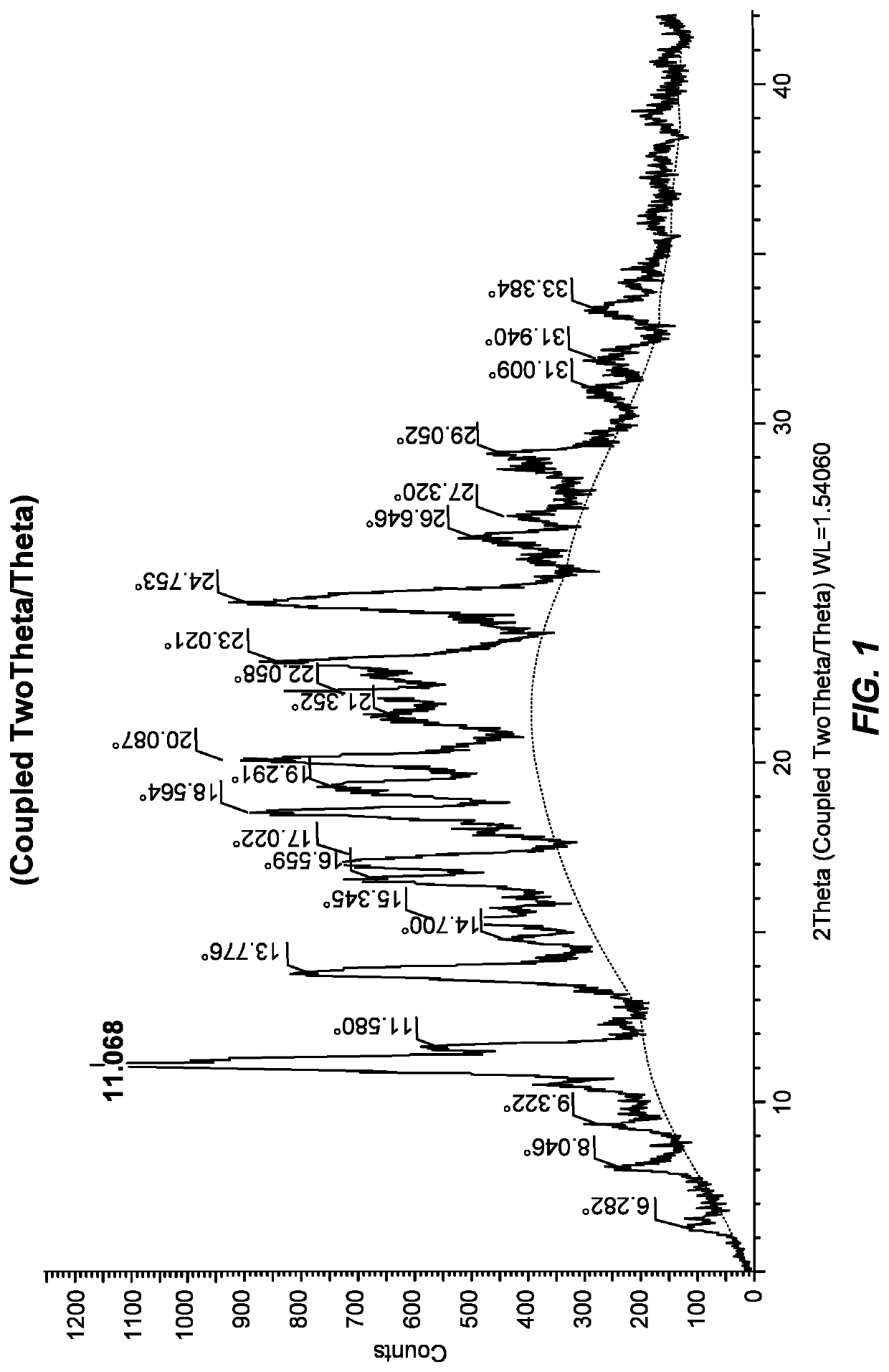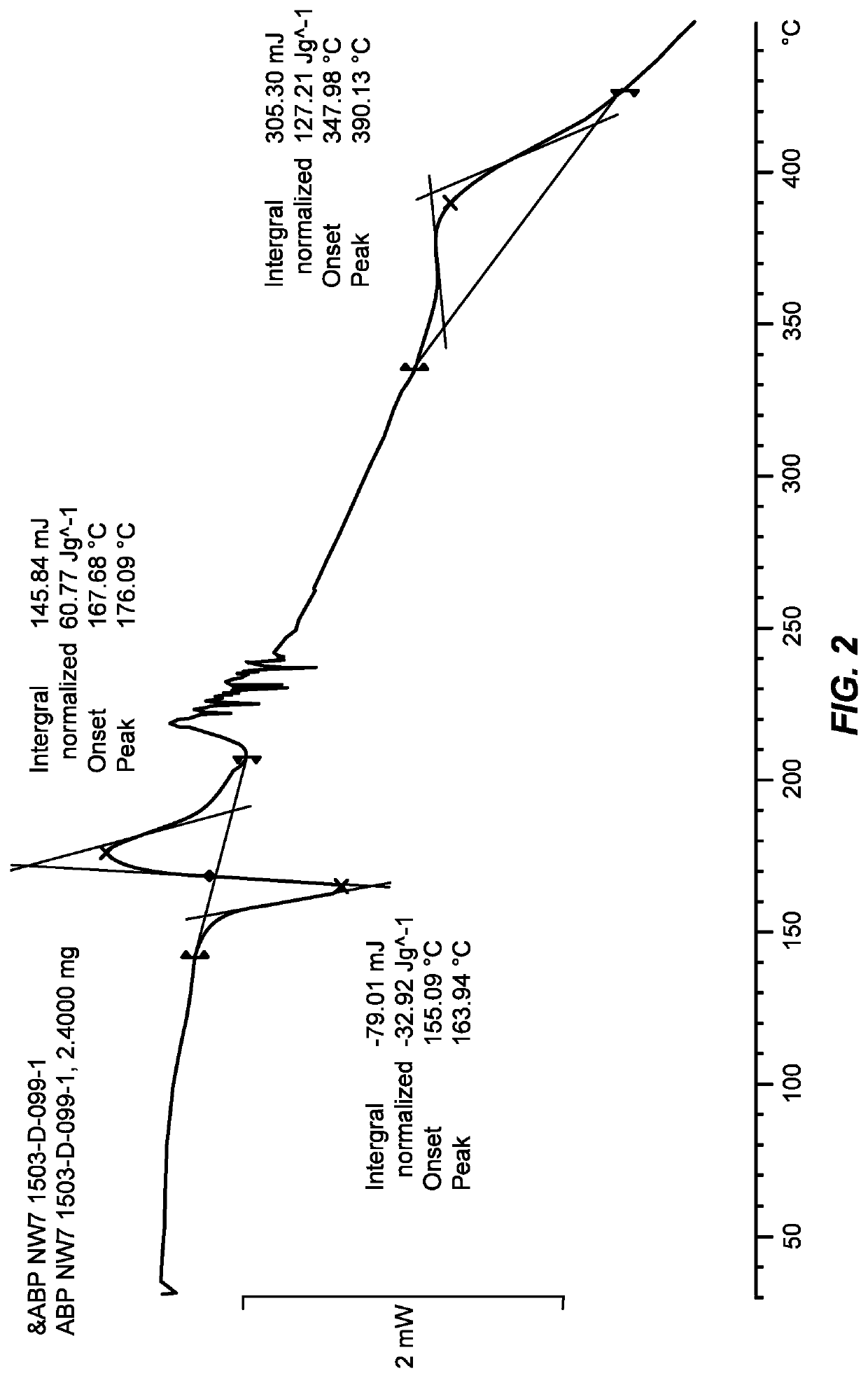Crystalline forms of a cd73 inhibitor and uses thereof
a cd73 inhibitor and inhibitor technology, applied in the field of crystalline forms of cd73 inhibitors, can solve the problems of less than ideal physical and metabolic stability, hampered development of small molecules, etc., and achieve the effects of reducing the time to relapse of post-transplant malignancy, reducing the time to relapse, and increasing the relapse-free survival tim
- Summary
- Abstract
- Description
- Claims
- Application Information
AI Technical Summary
Benefits of technology
Problems solved by technology
Method used
Image
Examples
example 1
on of crystalline Forms A and B of [({[(2R,3S,4R,5R)-5-(6-chloro-4-{[(1S)-1-(2-fluorophenyl)ethyl]amino}-1H-pyrazolo[3,4-b]pyridin-1-yl)-3,4-dihydroxyoxolan-2-yl]methoxy}(hydroxy)phosphoryl)methyl]phosphonic acid
[0335]
[0336]Step 1: The heterocycle (25 g, 133 mmol) and ammonium sulfate (175 mg, 1 mol %) were charged in a 1 L round bottom flask equipped with a magnetic stir bar. HMDS (133 mL, 1M) was added and the mixture was refluxed for 4 hours under an air atmosphere (heating block temperature 155° C.). Excess HMDS was evaporated under vacuum at 60° C. and then the flask was placed under high vacuum at 45° C. for 30 minutes. This operation was repeated to make sure all excess HMDS was removed.
[0337]The pale orange oil residue was dissolved in anhydrous MeCN (266 mL) and the sugar (46.55 g, 146.3 mmol) was added. The resulting mixture was stirred until all the sugar was dissolved (typically 5 min., yellow solution). TMSOTf (4.8 mL, 26.6 mmol) was then added dropwise over 20 minutes ...
example 2
on of Crystalline Form I of Formula (I)
[0343]A flask was charged with Form A of Example 1 (1.00 g) and denatured EtOH (5 mL, 5 parts). The resulting mixture was heated to ˜55-60° C. to form a first clear solution. Toluene (10.0 mL, 10 parts) was added at a temperature of 55-60° C. to form a second clear solution. The second clear solution was allowed to cool to room temperature over ˜1.5 hours, and stirred at room temperature overnight (about 18 hours) to form a white suspension. The white solid was collected by vacuum filtration, rinsed with 1:1 EtOH / toluene (2 parts), and dried at 55-60° C. under vacuum for 3 days to afford the Form I as a white solid (0.82 g, 82% yield, containing 0.04 wt % ethanol and about 0 wt % toluene).
[0344]The crystalline Form I was characterized by an XRPD pattern as shown in FIG. 1 and was further characterized by a differential scanning calorimetry (DSC) thermogram as shown in FIG. 2.
[0345]Similar results are observed using Form B as the starting materi...
example 3
ve Preparation of Crystalline Form I of Formula (I)
[0346]A flask was charged with 3.5 g of Form A or Form B and suspended in 17.5 mL of anhydrous absolute EtOH. The reaction mixture was heated to 35-40° C., resulting in a clear solution. Next, 35 mL of EtOAc was added to the solution portion wise over a period of 30 minutes while maintaining the temperature at 35-40° C. The mixture was subsequently allowed to cool to 20-25° C., at which time the solution became a slurry. The slurry was allowed to stir for 18 hr. The mixture was further chilled to 0-5° C. and maintained at that temperature for 6 hr. The resulting solids were filtered through a Buchner funnel and suction dried under N2 for 18 hr. The solids were identified as Form I by XRPD.
[0347]Similar results are observed using Form B as the starting material.
PUM
| Property | Measurement | Unit |
|---|---|---|
| melting point | aaaaa | aaaaa |
| 2θ | aaaaa | aaaaa |
| 2θ | aaaaa | aaaaa |
Abstract
Description
Claims
Application Information
 Login to View More
Login to View More - R&D
- Intellectual Property
- Life Sciences
- Materials
- Tech Scout
- Unparalleled Data Quality
- Higher Quality Content
- 60% Fewer Hallucinations
Browse by: Latest US Patents, China's latest patents, Technical Efficacy Thesaurus, Application Domain, Technology Topic, Popular Technical Reports.
© 2025 PatSnap. All rights reserved.Legal|Privacy policy|Modern Slavery Act Transparency Statement|Sitemap|About US| Contact US: help@patsnap.com



